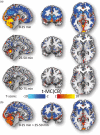Dynamic brain glucose metabolism identifies anti-correlated cortical-cerebellar networks at rest
- PMID: 28534658
- PMCID: PMC5718328
- DOI: 10.1177/0271678X17708692
Dynamic brain glucose metabolism identifies anti-correlated cortical-cerebellar networks at rest
Abstract
It remains unclear whether resting state functional magnetic resonance imaging (rfMRI) networks are associated with underlying synchrony in energy demand, as measured by dynamic 2-deoxy-2-[18F]fluoroglucose (FDG) positron emission tomography (PET). We measured absolute glucose metabolism, temporal metabolic connectivity (t-MC) and rfMRI patterns in 53 healthy participants at rest. Twenty-two rfMRI networks emerged from group independent component analysis (gICA). In contrast, only two anti-correlated t-MC emerged from FDG-PET time series using gICA or seed-voxel correlations; one included frontal, parietal and temporal cortices, the other included the cerebellum and medial temporal regions. Whereas cerebellum, thalamus, globus pallidus and calcarine cortex arose as the strongest t-MC hubs, the precuneus and visual cortex arose as the strongest rfMRI hubs. The strength of the t-MC linearly increased with the metabolic rate of glucose suggesting that t-MC measures are strongly associated with the energy demand of the brain tissue, and could reflect regional differences in glucose metabolism, counterbalanced metabolic network demand, and/or differential time-varying delivery of FDG. The mismatch between metabolic and functional connectivity patterns computed as a function of time could reflect differences in the temporal characteristics of glucose metabolism as measured with PET-FDG and brain activation as measured with rfMRI.
Keywords: 2-Deoxyglucose; blood-oxygenation level dependent contrast; energy metabolism; magnetic resonance imaging; pharmacokinetics.
Figures






References
-
- Biswal B, Yetkin F, Haughton V, et al. Functional connectivity in the motor cortex of resting human brain using echo-planar MRI. Magn Reson Med 1995; 34: 537–541. - PubMed
MeSH terms
Substances
LinkOut - more resources
Full Text Sources
Other Literature Sources

